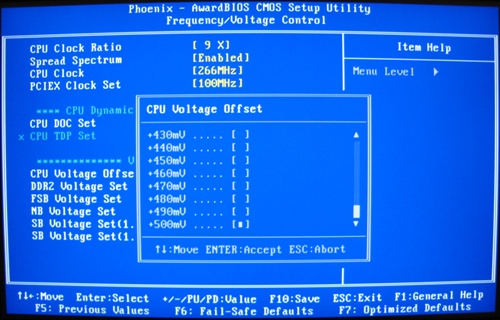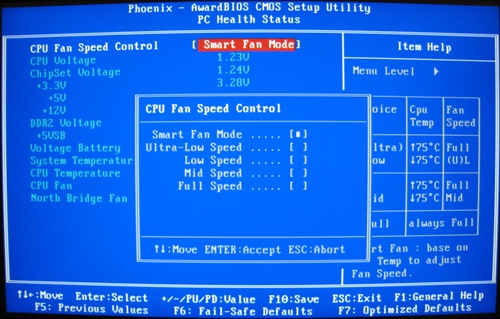Shuttle SG33G5: Black Beauty or Black Sheep?
by Matt Campbell on December 13, 2007 12:02 AM EST- Posted in
- Systems
Setup and Test Configuration


The BIOS is a streamlined Phoenix version. FSB speeds are adjustable from 200MHz to 600MHz (though you won't come anywhere near 600MHz in practice), and you can adjust voltages on the CPU, RAM, Northbridge, etc. However, it is not possible to set the memory divider in the same menu (Frequency/Voltage Control). Instead, the "System Memory Frequency" option is found in the "Advanced Chipset Features" menu, and can only be set to "By SPD", or in manual modes to 667 or 800.

With the Corsair XMS2 RAM used, "By SPD" and 667 both correspond to a 4:5 divider, while the 800 setting corresponds to a 2:3 divider. Needless to say, the lack of precise settings, and particularly a 1:1 ratio, is limiting if trying to push the performance as high as possible. We will discuss this further in the overclocking section.
System Configuration
| System Test Bed | |
| Processor | Intel Core 2 Quad Q6600 |
| RAM | 2x1GB Corsair XMS2 |
| Hard Drive | Seagate 7200.10 320GB |
| Optical Drive | Lite-On 16X DVD |
| Video Cards | GMA
3100 (integrated) NVIDIA 8800GT 512MB |
| Drivers | ForceWare 169.02 |
| Operating System | Windows Vista Ultimate 32-bit |










16 Comments
View All Comments
complectus - Thursday, December 13, 2007 - link
What is the point of showing graphs of performance figures without anything to compare them to? Are we supposed to have committed to memory a range of Cinebench results so we know where this product stands?JonathanYoung - Thursday, December 13, 2007 - link
I, too, have had negative experiences with Shuttle. One of the worst offenders was their KM400 model. On paper, it supported 333MHz FSB Athlon XPs, but I never found one that could. It was obviously a Shuttle problem because 1) regular ATX KM400 boards supported 333MHz AXPs and 2) there were tons of other users who had the same problem (there was a huge thread over at Sudhian for awhile).To sum it up, Shuttles look nice and appealing, but their QC leaves a little to be desired.
Flunk - Saturday, December 15, 2007 - link
I have a shuttle with a KM400 chipset too and it is currently working just fine with a barton 2500+ processor. One thing though, the board has a physical jumper on the board that you must set to change the FSB, it is listed in the manual. Perhaps you have a similar issue?retrospooty - Thursday, December 13, 2007 - link
I have a shuttle sk43g with K400M chipset. I bought it used, and built it for my son, and it has been working for well, overclocked on the 333mhz bus for over 3 years... In the Arizona heat. Never an issue, never a problem with it at all, and he is often on all day and 1/2 the night. Maybe you just had a bad one.Frumious1 - Thursday, December 13, 2007 - link
My experience with Shuttle SFFs has been ... poor would be a kind way of putting it. We sold these at the computer shop I work at for a while. All was fine for about six months, and then the stupid things started coming back! I bet more than half of them came in for repairs within the two years. Needless to say, we don't carry SFFs anymore.These were the socket 939 models (SN95G5), so maybe the newer ones are better, but they appear to use the same old power supplies. Oh, and these 939 units somehow didn't work with X2 chips when those came out. Anyway, the PSUs were the point of failure most of the time.
I'll stick with regular PCs, thanks. Cheaper, quieter, AND more reliable! Three strikes, Shuttle. You're out.
sprockkets - Friday, December 14, 2007 - link
Out of curiosity, did those systems have the Shuttle branded power supplies or HiPRO? All the OEMs seem to like HiPRO now for simple reasons: They are complete crap and cost less.But hey, I make $60-$240 labor having to replace the power supply which killed the motherboard which then usually requires a OS reinstall, so I guess Dell, HP, Shuttle and others can keep using them.
No pictures of the inside? WTF?